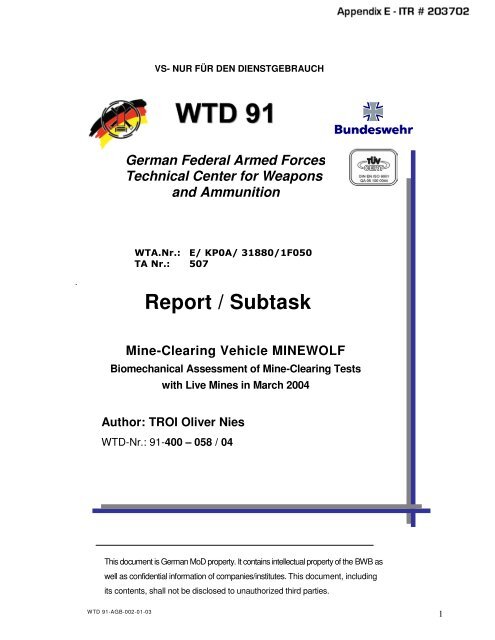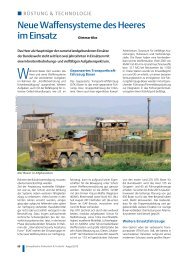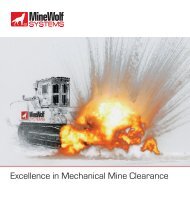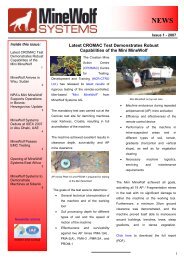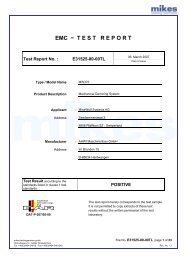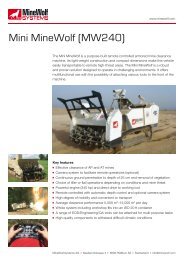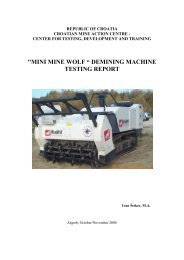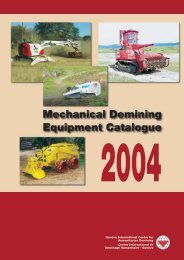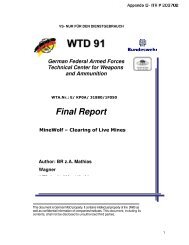Report / Subtask - MineWolf
Report / Subtask - MineWolf
Report / Subtask - MineWolf
Create successful ePaper yourself
Turn your PDF publications into a flip-book with our unique Google optimized e-Paper software.
.<br />
WTD 91-AGB-002-01-03<br />
VS- NUR FÜR DEN DIENSTGEBRAUCH<br />
German Federal Armed Forces<br />
Technical Center for Weapons<br />
and Ammunition<br />
<strong>Report</strong> / <strong>Subtask</strong><br />
Mine-Clearing Vehicle MINEWOLF<br />
Biomechanical Assessment of Mine-Clearing Tests<br />
with Live Mines in March 2004<br />
Author: TROI Oliver Nies<br />
WTD-Nr.: 91-400 – 058 / 04<br />
This document is German MoD property. It contains intellectual property of the BWB as<br />
well as confidential information of companies/institutes. This document, including<br />
its contents, shall not be disclosed to unauthorized third parties.<br />
1
Abtract<br />
German Federal Armed Forces<br />
Technical Center for Weapons and Ammunition<br />
Schießplatz, 49716 Meppen<br />
<strong>Subtask</strong> designation: <strong>MineWolf</strong>-Clearing of Live Mines:Human Engineering<br />
<strong>Subtask</strong> No.:<br />
<strong>Subtask</strong> Manager<br />
Internal ID No.: 45602<br />
31880/ 507<br />
Period of testing 15.01.2004 - 30.06.2004<br />
WTD 91<br />
lfd. WTA - No.: lfd. TA- No.<br />
450 Nies 2905<br />
OrgKz Name Tel.<br />
In March 2004, tests were conducted with the mine-clearing vehicle <strong>MineWolf</strong>, during which live antitank mines were<br />
cleared both with the flail and with the tiller. During four tests an instrumented ATD was placed on the driver's seat. The<br />
measured values had to be evaluated with a view to possible risks to the operator during mine-clearing.<br />
The evaluation showed that the detonation of a mine in the area of the mine-clearing device does not cause an<br />
intolerable risk of injury. In case of a detonation underneath the vehicle, however, a risk for the operator cannot be ruled<br />
out. To avoid auditory defects, both the operator and persons outside the immediate danger area should wear ear<br />
protection.<br />
Key words: <strong>MineWolf</strong>, mine-clearing tests, biomechanics, human engineering, human & technology<br />
Distribution: No. of pages 29<br />
WTD 91 – 310 3 EA<br />
DirWTD 91 1 EA<br />
BWB - FISt 1 EA<br />
WTD 91 – 450 2 EA<br />
<strong>Report</strong> / <strong>Subtask</strong><br />
WTD No.: 91 - 300 - 143/04<br />
Ref.: 90 - 13 - 45<br />
Project designation: Landmine Counter Measures<br />
Project number: 1F050<br />
Requesting authority: BWB<br />
Requesting section : BWB K61 Kasper 2104<br />
OrgKz Name Tel.<br />
Defense Technical Order (WTA)<br />
Meppen 05.07.2004<br />
Tel.: 05931 / 430<br />
Fax<br />
BwFw.: 90 2422- 88 (oder App.)<br />
2
<strong>MineWolf</strong> - Biomechanical assessment<br />
Table of Contents<br />
1. Task Description ................................................................................................. 4<br />
2. Summary of Results ............................................................................................ 4<br />
3. Short Description of the Test Item ....................................................................... 5<br />
4. Schedule and Required Effort........................Fehler! Textmarke nicht definiert.<br />
5. Detailed Description of Tests............................................................................... 6<br />
5.1 General................................................................................................................ 6<br />
5.2 Test Methods....................................................................................................... 6<br />
5.2.1 Head.................................................................................................................... 7<br />
5.2.2 Dorsal and Lumbar Spine .................................................................................... 8<br />
5.2.3 Upper Leg ........................................................................................................... 8<br />
5.2.4 Lower Leg........................................................................................................... 8<br />
5.2.5 Fragments ........................................................................................................... 9<br />
5.2.6 Lumbar Spine Force ............................................................................................ 9<br />
6. Determination of Results and Assessment ........................................................... 9<br />
6.1 Test 1 .................................................................................................................. 9<br />
6.1.1 Head.................................................................................................................... 9<br />
6.1.2 Dorsal and Lumbar Spine .................................................................................. 10<br />
6.1.3 Upper Leg ......................................................................................................... 10<br />
6.1.4 Lower Leg......................................................................................................... 12<br />
6.1.5 Fragments ......................................................................................................... 12<br />
6.2 Test 2 ............................................................................................................... 13<br />
6.2.1 Head.................................................................................................................. 13<br />
6.2.2 Dorsal and Lumbar Spine .................................................................................. 13<br />
6.2.3 Upper Leg ......................................................................................................... 15<br />
6.2.4 Lower Leg......................................................................................................... 15<br />
6.2.5 Fragments ......................................................................................................... 16<br />
6.3 Test 3 ................................................................................................................ 16<br />
6.3.1 Head.................................................................................................................. 16<br />
6.3.2 Dorsal and Lumbar Spine .................................................................................. 17<br />
6.3.3 Upper Leg ......................................................................................................... 17<br />
6.3.4 Lower Leg......................................................................................................... 19<br />
6.3.5 Fragments ......................................................................................................... 19<br />
6.4 Test 4 ................................................................................................................ 19<br />
6.4.1 Head.................................................................................................................. 19<br />
6.4.2 Dorsal and Lumbar Spine .................................................................................. 20<br />
6.4.3 Upper Leg ......................................................................................................... 20<br />
6.4.4 Lower Leg......................................................................................................... 22<br />
6.4.5 Fragments ......................................................................................................... 23<br />
6.5 Lumbar Spine Force .......................................................................................... 23<br />
List Figures……………………………………………………………………….29<br />
List of Tables……………………………………………………………………..29<br />
List of References………………………………………………………………...30<br />
List of Acronyms…………………………………………………………………31<br />
WTD 91 – 450 Mensch & Technik; Ergonomie<br />
3
1 Task Description<br />
In March 2004 tests were conducted at WTD 91 with the mine-clearing vehicle <strong>MineWolf</strong>,<br />
during which live antitank mine (ATM) types DM 21 and TM 57 were cleared. Four tests<br />
were first conducted in calendar week 10/04 with the vehicle remotely controlled. During<br />
these tests an ATD (Anthropomorphic Test Device = instrumented test dummy) was<br />
placed on the driver's seat, on which various sensors were attached to measure humanrelevant<br />
loads during mine-clearing. The evaluation of the measured data showed whether<br />
the <strong>MineWolf</strong> operator would be subject to an intolerable risk of injury during the clearing<br />
operation; this would have led to the consequence that no tests with human operators in<br />
the driver's cab would have been conducted at WTD 91.<br />
An initial evaluation showed that – provided certain precautionary measures were taken -<br />
there was no intolerable risk for the operator. These results were briefly presented to the<br />
safety board. The present report contains a detailed evaluation of the test results.<br />
2 Summary of Results<br />
During normal clearing operation there is no intolerable risk of injury for the <strong>MineWolf</strong><br />
operator sitting in the driver's cab. Temporary minor disturbances like headache or<br />
muscular pain are possible, especially if loads occur repeatedly at short intervals. Due to<br />
the blast pressure load caused by the mine detonations, however, it is necessary that the<br />
operator wears ear protection both when mounted and when dismounted, because<br />
otherwise he might suffer auditory defects.<br />
Should a mine detonate underneath a track or underneath the vehicle itself, which – due to<br />
the design of the <strong>MineWolf</strong> is not very likely but still possible – completely different effects<br />
have to be considered.<br />
have to be considered.<br />
wears ear protection both when mounted and when dismounted, because<br />
otherwise he might suffer auditory defects.<br />
<strong>MineWolf</strong> - Biomechanical assessment<br />
Should a mine detonate underneath a track or underneath the vehicle itself, which – due to<br />
the design of the <strong>MineWolf</strong> is not very likely but still possible – completely different effects<br />
have to be considered.<br />
WTD 91 – 450 Mensch & Technik; Ergonomie<br />
4
Based on the tests conducted so far, no statements can be made on the consequences for<br />
the operator in this case. Intolerable loads, i.e. when the applicable limits for mine<br />
protection tests are exceeded or the mine protection criteria are not fullfilled, cannot be<br />
excluded according to the present state of knowledge.<br />
To ensure the greatest possible degree of safety for the operator, it is recommended –<br />
analogously to the tests with mine-protected vehicles – to perform static contact<br />
detonations with charges placed underneath the track and underneath the vehicle, which<br />
have to be evaluated using the valid biomechanical assessment methods and criteria.<br />
Only then will it be possible to make a final statement on the risk of injury for the operator<br />
in the event of a mine detonation outside the mine-clearing device.<br />
3 Short Description of the Test Item<br />
The tests were conducted with a fully operational <strong>MineWolf</strong> as well as both types of mineclearing<br />
devices, i.e. flail and tiller. The vehicle could be operated both in remote control<br />
mode and by an operator sitting inside the driver's cab.<br />
4 Schedule and Required Effort<br />
Test site: WTD 91, Meppen<br />
Test period: calendar week 10/2004<br />
<strong>MineWolf</strong> - Biomechanical assessment<br />
WTD 91 – 450 Mensch & Technik; Ergonomie<br />
5
5. Detailed Description of Tests<br />
5.1 General<br />
The tests were conducted on the premises of WTD 91 with original antitank mines DM 21<br />
(5.6 kg TNT) and TM 57 (6.5 kg TNT) that had been buried. This report covers only those<br />
tests which served to gather human-relevant data. To this end, one test each with the flail<br />
and the tiller was performed for each mine type. Thus, a total of four tests has to be<br />
evaluated. Table 1 shows an overview of the marginal conditions. More detailed data are<br />
contained in the report prepared by WTD 91 – 310.<br />
Table 1: Marginal Conditions of Tests 1 – 4<br />
5.2 Test Methods<br />
<strong>MineWolf</strong> - Biomechanical assessment<br />
Test 1 Test 2 Test 3 Test 4<br />
Date 01 Mar 2004 02 Mar 2004 02 Mar 2004 03 Mar 2004<br />
Mine DM 21 TM 57 DM 21 TM 57<br />
Clearing device flail flail tiller tiller<br />
The vehicle operator was replaced by an anthropomorphic hybrid III-ATD of the 50 th male<br />
percentile. It was fitted with triaxial acceleration sensors in its head. On its lower leg, which<br />
was a THOR-Lx type, the forces and accelerations were measured triaxially. Furthermore,<br />
a uniaxial force sensor was installed in the right upper leg to measure the shear force. To<br />
determine the loads on the dorsal and the lumbar spine, the accelerations induced across<br />
the driver's seat surface were measured. To this end, the ATD was placed on a cushion<br />
into which a triaxial acceleration sensor was integrated. In addition, the axial spine force<br />
was measured.<br />
WTD 91 – 450 Mensch & Technik; Ergonomie<br />
6
In addition to the measurements performed on the ATD, acceleration measuring points<br />
were installed on the driver's cab floor and at the seat. These measurements also served<br />
the purpose of making the tests comparable with previous tests on mine-clearing vehicles,<br />
since similar measurements had been performed there.<br />
The human-related assessment of the loads for the operator was based on the<br />
assessment methods and criteria specified for mine-protected vehicles, which are also<br />
applicable in this case. Limit values and tolerance limits are defined for the different body<br />
regions. The criteria are shortly described in the following. For further details see the<br />
relevant technical literature.<br />
The human-related assessment is subject to a master criterion which stipulates that a<br />
probability of injury (AIS ~ 2) of 5 % must not be exceeded.<br />
5.2.1 Head<br />
<strong>MineWolf</strong> - Biomechanical assessment<br />
The criterion for the head is the "No Impact Criterion" (NICon) [1]. This means that the<br />
head of the ATD shall not hit the vehicle roof or other vehicle components. In this case the<br />
design of the driver's cab and the operator position were such that an impact of the head<br />
was highly unlikely. Thus, no specific individual demonstration was necessary. The<br />
criterion is considered fulfilled for all tests.<br />
WTD 91 – 450 Mensch & Technik; Ergonomie<br />
7
5.2.2 Dorsal and Lumbar Spine<br />
The method used to assess the probabilities of injury of the dorsal and lumbar spine is the<br />
"Dynamic Response Index" (DRI) [2,3]. The DRI describes the behavior of the spine by means of a<br />
cushioned spring-mass system. The acceleration/time histories in X, Y and Z direction are used<br />
as input parameters. On this basis the deformation of the spine and thus the respective<br />
probability of injury in X, Y and Z direction is determined.<br />
The probabilities of injury shall not exceed 5%.<br />
5.2.3 Upper Leg<br />
At present, only a static method – the Femur Shear Force Criterion (FSFC) – is available for<br />
the assessment of the upper leg load. The shear force in the upper leg is used as a<br />
parameter. This force shall not exceed 2860 N [1].<br />
5.2.4 Lower Leg<br />
<strong>MineWolf</strong> - Biomechanical assessment<br />
To assess the probability of injury of the lower leg the "Lower Leg Threshold" (LLTH) is used,<br />
where the acceleration-time histories serve as input parameters [4]. The mean resulting<br />
acceleration is calculated from these by integration. The time of exposure to be considered<br />
is the onset duration of the velocity history. For short times of exposure, a tolerable mean<br />
acceleration is assigned to a certain time of exposure. A quasi-static limit of 20 g applies to<br />
times of exposure of more than 20 ms, which must not be exceeded.<br />
WTD 91 – 450 Mensch & Technik; Ergonomie<br />
8
5.2.5 Fragments<br />
The criterion for fragmentation is the "No Fragment Criterion" (NFC) [1]. This means that<br />
no fragments may occur in the driver's cab, neither those caused by ruptures or<br />
penetrations from outside (primary fragments) nor any caused by secondary<br />
fragmentation.<br />
5.2.6 Lumbar Spine Force<br />
The lumbar spine force is not a criterion for mine protection tests since the area of the<br />
spine is covered by the DRI. Therefore, this force is normally not measured. In the present<br />
case it was recorded as a supplementary information. A limit is not defined, however.<br />
6. Determination of Results and Assessment<br />
6.1 Test 1<br />
6.1.1 Head<br />
<strong>MineWolf</strong> - Biomechanical assessment<br />
Fig. 1 shows the acceleration history in the head of the ATD. The measured values in X<br />
and Y direction are very low. The sensor for the Z axis had failed. As can be seen, the<br />
measured accelerations have a relatively high frequency and are so low that they are<br />
already within the range of measurement inaccuracies. Injuries in the head area are not to<br />
be expected. Since there was no head impact, the NICon is also fulfilled.<br />
WTD 91 – 450 Mensch & Technik; Ergonomie<br />
9
Fig. 1: Head Acceleration Test (Test 1)<br />
6.1.2 Dorsal and Lumbar Spine<br />
Fig. 2 shows the DRI histories in X, Y and Z direction. The probability of injury in all three<br />
directions is less than 5 %. The criterion is thus fulfilled.<br />
6.1.3 Upper Leg<br />
<strong>MineWolf</strong> - Biomechanical assessment<br />
Fig. 3 shows the shear force history in the right upper leg. The measured values are again<br />
within the range of the intrinsic noise of the measuring system, as can be seen from the<br />
diagram. The values are far below the limit of 2860 N. The FSFC is thus fulfilled.<br />
WTD 91 – 450 Mensch & Technik; Ergonomie<br />
10
<strong>MineWolf</strong> - Biomechanical assessment<br />
Fig. 2: DRI Histories in X, Y and Z Direction (Test 1)<br />
WTD 91 – 450 Mensch & Technik; Ergonomie<br />
11
Fig. 3: Upper Leg Shear Force (Test 1)<br />
6.1.4 Lower Leg<br />
Fig. 4 shows the acceleration history in the right lower leg. The quasi-static limit value of<br />
20 g is not exceeded, thus no further evaluation in accordance with the LLTH is required. The<br />
criterion is fulfilled.<br />
Fig. 4: Acceleration History in the Lower Leg (Test 1)<br />
6.1.5 Fragments<br />
<strong>MineWolf</strong> - Biomechanical assessment<br />
No primary or secondary fragments occurred in the driver's cab. The NFC is thus fulfilled.<br />
WTD 91 – 450 Mensch & Technik; Ergonomie<br />
12
6.2 Test 2<br />
6.2.1 Head<br />
Fig. 5 shows the acceleration history in the head of the ATD. Again, the measured values<br />
are very low and comparable to those of test 1. Injuries in the head area are not to be<br />
expected. Since no head impact occurs, the NICon is fulfilled.<br />
Fig. 5: Head Acceleration (Test 2)<br />
6.2.2 Dorsal and Lumbar Spine<br />
<strong>MineWolf</strong> - Biomechanical assessment<br />
Fig. 6 shows the DRI histories in X, Y and Z direction. The probability of injury in all three<br />
directions is less than 5 %. The criterion is thus fulfilled. Fig. 6 shows the DRI histories in X, Y and<br />
Z direction. The probability of injury in all three directions is less than 5 %. The criterion is thus<br />
fulfilled.<br />
WTD 91 – 450 Mensch & Technik; Ergonomie<br />
13
Fig. 6: DRI Histories in X, Y, Z Direction<br />
<strong>MineWolf</strong> - Biomechanical assessment<br />
WTD 91 – 450 Mensch & Technik; Ergonomie<br />
14
6.2.3 Upper Leg<br />
Fig. 7 shows the shear force history in the right upper leg. As can be seen, the measuring<br />
sensors failed (presumably a broken cable). Therefore, an assessment on the basis of the<br />
measured data is not possible for test 2. In view of the other results for test 2 and the upper<br />
leg data of the other tests, the probability is very high that the limit of 2860 N was not<br />
exceeded.<br />
Fig. 7: Upper Leg Shear Force (Test 2)<br />
6.2.4 Lower Leg<br />
<strong>MineWolf</strong> - Biomechanical assessment<br />
Fig. 8 shows the acceleration history in the right lower leg. The values are slightly higher<br />
than in test 1 but are generally very low. The quasi-static limit value of 20 g is not exceeded,<br />
thus no further evaluation in accordance with the LLTH is required. The criterion is thus fulfilled.<br />
WTD 91 – 450 Mensch & Technik; Ergonomie<br />
15
Fig. 8: Acceleration History in the Lower Leg (Test 2)<br />
6.2.5 Fragments<br />
No primary or secondary fragments occurred in the driver's cab. The NFC is thus fulfilled.<br />
6.3 Test 3<br />
6.3.1 Head<br />
<strong>MineWolf</strong> - Biomechanical assessment<br />
Fig. 5 shows the acceleration history in the head of the ATD. Due to the results from<br />
tests 1 and 2 the measuring range was adjusted to provide for a better representation.<br />
Again, the measured values are very low and comparable to those of tests 1 and 2.<br />
Injuries in the head area are not to be expected. Since no head impact occurs, the<br />
NICon is fulfilled.<br />
WTD 91 – 450 Mensch & Technik; Ergonomie<br />
16
Fig. 9: Head Acceleration (Test 3)<br />
6.3.2 Dorsal and Lumbar Spine<br />
<strong>MineWolf</strong> - Biomechanical assessment<br />
Fig. 10 shows the DRI histories in X, Y and Z direction. The probability of injury in all three<br />
directions is less than 5 %. The criterion is thus fulfilled.<br />
6.3.3 Upper Leg<br />
During test 3 the measuring sensor failed again, so that no valid data of the upper leg load<br />
are available. Thus, no assessment according to the FSFC is possible.<br />
WTD 91 – 450 Mensch & Technik; Ergonomie<br />
17
<strong>MineWolf</strong> - Biomechanical assessment<br />
Fig.10: DRI Histories in X, Y, Z Direction (Test 3)<br />
WTD 91 – 450 Mensch & Technik; Ergonomie<br />
18
6.3.4 Lower Leg<br />
<strong>MineWolf</strong> - Biomechanical assessment<br />
Fig. 11 shows the acceleration history in the right lower leg. As can be seen, the quasi-static<br />
limit value of 20 g is not exceeded. Thus, thus no further evaluation in accordance with the<br />
LLTH is required. The criterion is fulfilled.<br />
Fig. 11: Acceleration History in the Lower Leg (Test 3)<br />
6.3.5 Fragments<br />
No primary or secondary fragments occurred in the driver's cab. The NFC is thus fulfilled.<br />
6.4 Test 4<br />
6.4.1 Head<br />
Fig. 12 shows the acceleration history in the head of the ATD. Again, the measured values<br />
are very low and comparable to those of the previous tests. Injuries in the head area are not<br />
to be expected. Since no head impact occurs, the NICon is fulfilled.<br />
WTD 91 – 450 Mensch & Technik; Ergonomie<br />
19
Fig. 12: Head Acceleration (Test 4)<br />
6.4.2 Dorsal and Lumbar Spine<br />
<strong>MineWolf</strong> - Biomechanical assessment<br />
Fig. 13 shows the DRI histories in X, Y and Z direction. The probability of injury in all three<br />
directions is less than 5 %. The criterion is thus fulfilled..<br />
6.4.3 Upper Leg<br />
Fig. 14 shows the measured shear force history in the right upper leg. The unusual curve<br />
suggests the existence of a measuring error. Therefore, no final assessment according to<br />
the FSFC is made.<br />
WTD 91 – 450 Mensch & Technik; Ergonomie<br />
20
<strong>MineWolf</strong> - Biomechanical assessment<br />
Fig.13: DRI Histories in X, Y, Z Direction (Test 4)<br />
WTD 91 – 450 Mensch & Technik; Ergonomie<br />
21
Fig. 14: Upper Leg Shear Force (Test 4)<br />
6.4.4 Lower Leg<br />
<strong>MineWolf</strong> - Biomechanical assessment<br />
Fig. 15 shows the acceleration history in the right lower leg. As can be seen, the measured<br />
values are higher than in the previous tests but the quasi-static limit value of 20 g is again<br />
not exceeded. Thus, thus no further evaluation in accordance with the LLTH is required in<br />
this case either. The criterion is fulfilled.<br />
Fig. 15: Acceleration History<br />
in the Lower Leg (Test 4)<br />
WTD 91 – 450 Mensch & Technik; Ergonomie<br />
22
6.4.5 Fragments<br />
<strong>MineWolf</strong> - Biomechanical assessment<br />
No primary or secondary fragments occurred in the driver's cab. The NFC is thus<br />
fulfilled.<br />
6.5 Lumbar Spine Force<br />
In addition to the above-mentioned and assessed human relevant measurements, the<br />
axial force in the spine, the so called lumbar spine force, was also measured in tests<br />
2 – 4. Fig. 16 shows the results. As can be seen, the maximum values are within the<br />
range of 1000 N. There is presently no criterion for mine protection investigations that<br />
takes the lumbar spine force into account, but this force is relatively small so that no<br />
spinal injuries are to be expected due to the compressive force. This assessment<br />
corresponds with the evaluation of accelerations according to the DRI, which in all tests<br />
also resulted in very low values and probabilities of injury for the dorsal and lumbar<br />
spine.<br />
The measured forces can be compared to those measured in the contact detonation<br />
tests conducted by RUAG [5]. Thus, the above assessment of the results with respect<br />
to risks of injury confirms the conclusions of RUAG and is in line with the biomechanical<br />
assessment made by WTD 91 [6] on the basis of the RUAG report [5].<br />
WTD 91 – 450 Mensch & Technik; Ergonomie<br />
23
<strong>MineWolf</strong> - Biomechanical assessment<br />
Fig. 16: Lumbar Spine Forces (Test 2 - 4)<br />
WTD 91 – 450 Mensch & Technik; Ergonomie<br />
24
6.6 Blast Pressure Load<br />
<strong>MineWolf</strong> - Biomechanical assessment<br />
Table 2 shows the measured maximum pressures, pressure levels and times of exposure.<br />
The results of the nine tests were averaged by WTD 91 – 630. This is normally not useful<br />
since the tests were conducted under different conditions (flail and tiller, various mines).<br />
However, in this case the differences between the individual tests are so small that<br />
averaging yields a relatively good and useful result.<br />
Table 2: Blast Pressure Values (source: WTD 91 – 630)<br />
Fig. 17 shows the limiting level diagram according to Pfander [7]. The violet marking<br />
identifies the area where the pressure loads measured during the nine tests belong. As<br />
already mentioned, an exact differentiation is not necessarily required due to the relatively<br />
small differences, and is therefore not made. The exact values are contained in the<br />
measurement record of WTD 91 – 630 and/or table 2.<br />
WTD 91 – 450 Mensch & Technik; Ergonomie<br />
25
Fig. 17: Limiting Level Diagram<br />
<strong>MineWolf</strong> - Biomechanical assessment<br />
As can be seen, auditory defects of the unprotected ear have to be assumed in all cases.<br />
Therefore, it is absolutely necessary for the mounted operator to use adequate ear<br />
protection. This was already recommended prior to the tests by WTD 91 [6] and the RUAG<br />
[5]. In addition to the measured values, table 2 shows the theoretically admissible number<br />
of loads per day when wearing a H-280 headset and/or a headset in connection with "MAX<br />
Lite" earplugs.<br />
The maximum pressures of 0.54 to 0.87 kPa measured in the driver's cab during the first<br />
tests at WTD 91 are approx. one tenth of those indicated by the RUAG [5] (50 mbar = 5<br />
kPa). The reason therefore is not reproducible. At any rate, the maximum pressure values<br />
are so low that non-auditory defects, for example pulmonary damage, are not to be<br />
expected.<br />
WTD 91 – 450 Mensch & Technik; Ergonomie<br />
26
6.7 Summary and Conclusion<br />
<strong>MineWolf</strong> - Biomechanical assessment<br />
During the four tests all human-related criteria were fulfilled to the extent that they could be<br />
evaluated. For tests 2 – 4 the upper leg shear force could not be assessed due a failure of<br />
the measuring equipment. The results from test 1 and the measured values for the lower<br />
legs and the pelvis, however, highly suggest that the admissible limit was not exceeded in<br />
these cases either. Therefore, the missing final assessment has no negative influence on<br />
the overall result.<br />
In all areas investigated the loads measured during tests 3 and 4 were higher than those in<br />
tests 1 and 2. This is explained by the fact that the tiller was used in tests 3 and 4, while<br />
the first two tests were conducted with the flail. Due to its design, the tiller transmits the<br />
loads released by the mine detonations better onto the vehicle structure than the flail; as a<br />
result, the driver's cab and the operator are subjected to higher loads. As already<br />
mentioned above, the overall loads are still very low.<br />
In summary it can be stated that the operator sitting in the driver's cab of the <strong>MineWolf</strong> is<br />
not subjected to an intolerable risk of injury by the explosion of a DM 21 or TM 57 antitank<br />
mine if the mine detonates in the area of the mine-clearing device. The risk of injury is very<br />
Low and far below the applicable limits for mine-protected vehicles of the Bundeswehr.<br />
The statements by the operator confirmed this analysis. Even in case of repeated<br />
successive loads no serious consequences have to be expected. Temporary light<br />
disturbances like headaches or muscular pain, however, cannot be excluded.<br />
WTD 91 – 450 Mensch & Technik; Ergonomie<br />
27
<strong>MineWolf</strong> - Biomechanical assessment<br />
The assessment of the blast pressure load in the driver's cab showed that non-auditory<br />
effects are not to be expected. There is no risk of permanent auditory defects if adequate<br />
ear protection is worn. The use of ear protection was already recommended by the RUAG<br />
[5] and WTD 91 [6] prior to the tests. Even for observers outside the direct danger area or<br />
the dismounted operator during remote control operation of the <strong>MineWolf</strong> it is absolutely<br />
necessary to wear suitable ear protection.<br />
Due to the principle of operation of the <strong>MineWolf</strong>, the detonation of a mine underneath the<br />
vehicle hull or a track during mine-clearing is not very likely, but cannot be ruled out.<br />
Based on the available measured data, the effects that an explosion underneath the hull or<br />
a track would have on the vehicle and the mounted operator cannot be assessed. It is<br />
definitely possible, however, that this would lead to critical loads. It is therefore<br />
recommended to investigate these cases – i.e. detonation underneath the vehicle hull or a<br />
track – by static contact detonation tests to be able to ensure the highest degree of safety<br />
for the <strong>MineWolf</strong> operator.<br />
WTD 91 – 450 Mensch & Technik; Egonomie<br />
28
List of Figures<br />
<strong>MineWolf</strong> - Biomechanical assessment<br />
Fig. 1: Head Acceleration (Test 1) 10<br />
Fig. 2: DRI Histories in X, Y, Z Direction (Test 1) 11<br />
Fig. 3: Upper Leg Shear Force (Test 1) 12<br />
Fig. 4: Acceleration History in the Lower Leg (Test 1) 12<br />
Fig. 5: Head Acceleration (Test 2) 13<br />
Fig. 6: DRI Histories in X, Y, Z Direction (Test 2) 14<br />
Fig. 7: Upper Leg Shear Force (Test 2) 15<br />
Fig. 8: Acceleration History in the Lower Leg (Test 2) 16<br />
Fig. 9: Head Acceleration (Test 3) 17<br />
Fig. 10: DRI Histories in X, Y, Z Direction (Test 3) 18<br />
Fig. 11: Acceleration History in the Lower Leg (Test 3) 19<br />
Fig.12: Head Acceleration (Test 4) 20<br />
Fig. 13: DRI Histories in X, Y, Z Direction (Test 4) 21<br />
Fig.14: Upper Leg Shear Force (Test 4) 22<br />
Fig. 15: Acceleration History in the Lower Leg (Test 4) 22<br />
Fig.16: Lumbar Spine Forces (Tests 2 – 4) 24<br />
Fig.17: Limiting Level Diagram 26<br />
List of Tables<br />
Table 1: Marginal Conditions of Tests 1 – 4 6<br />
Table 2: Blast Pressure Values 25<br />
WTD 91 – 450 Mensch & Technik; Ergonomie<br />
29
[1]<br />
<strong>MineWolf</strong> - Biomechanical assessment<br />
Dosquet, F.: „Minenbedrohung – Bewertung der Insassenbelastung“,<br />
Wehrtechnische Dienststelle für Waffen und Munition (WTD 91), Meppen, 2001<br />
("Mine Threat – Assessment of Load on Occupants")<br />
[2] Brinkley, J.W.; Specker, L.J.; Armstrong, H.G.; Mosher, S.E.: “Development of<br />
Acceleration Exposure Limits for Advanced Escape Systems”, in: Implications of<br />
Advanced Escape Technologies for Air and Spacecraft Escape, AGARD-CP-472,<br />
1989<br />
[3] Brinkley, J.W.; Shaffer, J.T.: “Dynamic Simulation Techniques for the Design of Escape<br />
Systems: Current Applications and Future Air Force Requirements”, Symposium on<br />
Biodynamic Models and their Applications, <strong>Report</strong> No. AMRL-TR-71-29, Aerospace<br />
Medical Research Laboratory, Wright-Patterson Air Force Base, Ohio, USA, 1970<br />
[4] Dosquet, F.: „Minenschutz von Fahrzeugen – Humanbezogene Bewertung der Belastung<br />
der Unterschenkel und Füße im Rahmen von Minenschutzversuchen“, Kurzbericht WTD<br />
91 Nr. 91 – 400 / 67 / 02, Wehrtechnische Dienststelle für Waffen und Munition (WTD<br />
91), Meppen, 2002<br />
("Mine Protection of Vehicles – Human-Related Assessment of Loads on Lower Legs<br />
and Feet during Mine Protection Tests")<br />
[5] Kaufmann, H.P.: „Minenschutztests am FUMU <strong>MineWolf</strong>“, Kurzbericht<br />
<strong>MineWolf</strong>0730.DOC, RUAG Land Systems, Thun, 2001 ("Mine Protection Tests with FUMU<br />
<strong>MineWolf</strong>")<br />
[6] Nies, O.: „<strong>MineWolf</strong> – Bewertung der von der RUAG durchgeführten Ansprengversuche<br />
am Mine Wolf aus humanbezogener Sicht“, Wehrtechnische Dienststelle für Waffen<br />
und Munition, WTD 91, Meppen, 2004 ("<strong>MineWolf</strong> – Assessment of the RUAG Contact<br />
Detonation Tests from a Human-Related View")<br />
[7] Pfander, F.: „Das Schalltrauma“, Bundesministerium der Verteidigung, Bonn, 1994 ("The<br />
Blast Trauma")<br />
WTD 91 – 450 Mensch & Technik; Ergonomie<br />
30
List of Acronyms<br />
ATD Anthropomorphic Test Device<br />
DRI Dynamic Response Index<br />
FSFC Femur Shear Force Criterion<br />
NFC No Fragment Criterion<br />
NICon No Impact Criterion<br />
LLTH Lower Leg Threshold<br />
APM Antipersonnel Mine<br />
ATM Antitank Mine<br />
<strong>MineWolf</strong> - Biomechanical assessment<br />
WTD 91 – 450 Mensch & Technik; Ergonomie<br />
31


